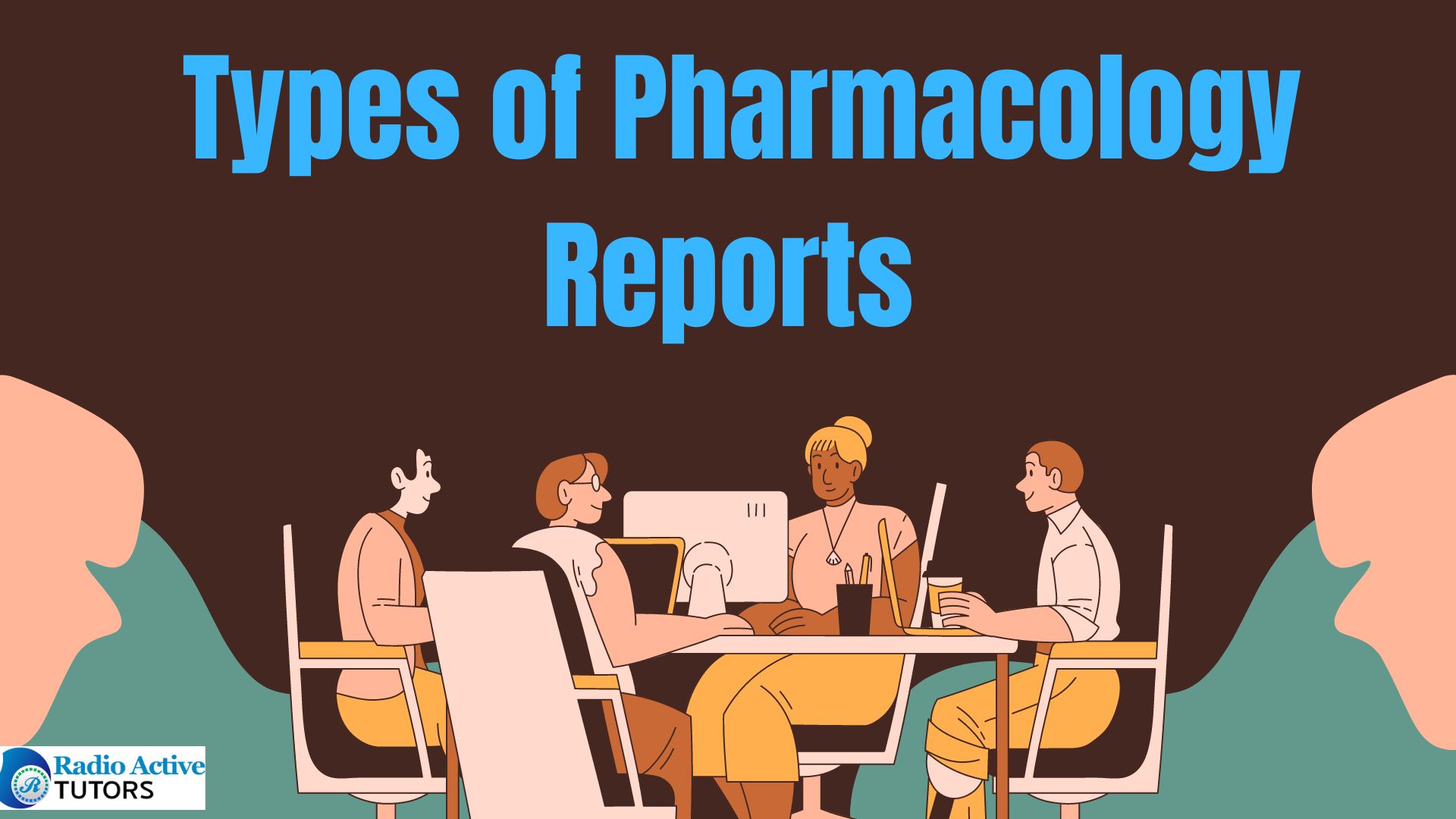Table of Contents
I. Introduction
II. Types of Pharmacology Reports
III. Structure of a Pharmacology Report
IV. Best Practices in Writing Pharmacology Reports
V. Frequently Asked Questions (FAQs) on Pharmacology Reports
I. Introduction
1.Understanding Pharmacology Reports
- Definition and Importance of Pharmacology Reports

Pharmacology, the science of how drugs interact with living organisms, forms the foundation for understanding the information presented in pharmacology reports. This guide delves into the intricacies of these pharmacology reports, but a solid grasp of pharmacology’s core principles is crucial. In essence, pharmacology examines how drugs are absorbed, distributed, metabolized, and eliminated by the body (often abbreviated as ADME), along with their mechanisms of action, or how they produce their intended effects. This knowledge empowers us to interpret the data in pharmacology reports, which detail a drug’s impact on various systems, potential side effects, and its overall efficacy in treating specific conditions.
- Historical Background of Pharmacology Reports
While modern pharmacology reports focus on rigorously tested medications, a historical perspective is invaluable. Understanding the long and often trial-and-error journey of drug discovery adds context to the reported findings. Early observations of plant and mineral remedies, even if based on anecdote, laid the groundwork for future scientific inquiry. The triumphs and tragedies of past medicines – from the pain relief of willow bark to the addictive properties of opium – inform our approach to drug development today. By appreciating the historical arc of pharmacology, we can better appreciate the advancements reported in this guide, while remaining vigilant for potential unforeseen consequences.
- Current Trends in Pharmacology Reporting
The landscape of pharmacology reporting is undergoing a dynamic shift. Traditional, siloed pharmacology reports are giving way to a more holistic approach that incorporates data from diverse fields. This includes pharmacogenomics, which explores how individual genetic variations influence drug response, and real-world evidence, gathered through large-scale studies monitoring medication use in everyday settings. Additionally, there’s a growing emphasis on patient-reported outcomes, ensuring a drug’s effectiveness aligns with patient experiences. These trends, reflected in this guide, represent a move towards personalized medicine and a deeper understanding of a drug’s impact on a broader population.
2. Purpose of Pharmacology Reports
Pharmacology reports serve as the cornerstone for informed decision-making in healthcare. These pharmacology reports synthesize a wealth of data on a drug’s properties, detailing its effects on the body, potential side effects, and its efficacy in treating specific diseases. By critically evaluating this information, healthcare professionals can determine if a drug is a suitable option for their patients, taking into account individual factors and potential interactions with other medications. Furthermore, pharmacology reports contribute to the ongoing development of new and improved treatments by highlighting areas for further research and pinpointing potential drawbacks of existing medications. Ultimately, these pharmacology reports aim to bridge the gap between scientific discovery and practical application, ensuring safe and effective drug use for optimal patient care.
II. Types of Pharmacology Reports

- Clinical Pharmacology Reports
Within the realm of pharmacology reports, clinical pharmacology reports occupy a central role. These pharmacology reports focus specifically on the effects of a drug in humans, providing crucial information gathered through clinical trials. They detail the drug’s safety profile, documenting potential adverse reactions and outlining appropriate dosages for different patient populations. Clinical pharmacology reports also assess the drug’s efficacy in treating targeted conditions, drawing on data from controlled studies to evaluate its effectiveness compared to existing treatments or a placebo. This information is paramount for regulatory bodies who determine a drug’s suitability for approval and widespread use.
2. Non-Clinical Pharmacology Reports
In contrast to clinical studies on humans, non-cellular and animal studies form the basis of non-clinical pharmacology reports. These pharmacology reports provide vital preliminary data on a drug’s properties before human testing commences. They explore the drug’s absorption, distribution, metabolism, and excretion (ADME) within an organism, offering insights into how the body handles the medication. Additionally, non-clinical reports investigate the drug’s mechanisms of action at a cellular level, shedding light on how it interacts with biological processes. Furthermore, these reports assess the drug’s potential for toxicity in various animals, helping to identify safety concerns and establish safe dosage ranges for initial human trials. By laying this groundwork, non-clinical pharmacology reports play a critical role in safeguarding human subjects during the early stages of drug development.
- Pharmacovigilance Reports
Distinct from the pre-clinical and clinical phases, pharmacovigilance reports offer a unique perspective on a drug’s safety profile. These reports focus on monitoring adverse events (side effects) experienced by patients using the medication in real-world settings, following its approval and market release. Unlike controlled clinical trials, pharmacovigilance data captures a broader range of patient experiences, including those with pre-existing conditions or taking medications concurrently. This allows for the identification of rare or unforeseen side effects that might not have emerged during clinical trials. By continuously gathering and analyzing pharmacovigilance reports, healthcare professionals can refine recommendations for drug use, update safety warnings, and contribute to the ongoing evaluation of a drug’s long-term risk-benefit profile.
III. Structure of a Pharmacology Report

1.Title and Abstract of a Pharmacology Report
When crafting a pharmacology report, a clear and concise title is paramount for both the report itself and the accompanying abstract. The title should accurately reflect the pharmacology report’s central focus, ideally incorporating keywords relevant to the drug, its mechanism of action, or the specific aspect of pharmacology under investigation. For instance, instead of a generic title like “Evaluation of a New Drug,” consider “Modulation of [Target Receptor] by [Drug Name]: In Vitro and In Vivo Analysis.” This approach not only informs readers about the report’s content but also enhances discoverability through search engines and databases. The same principle applies to the abstract, which should be a concise summary mirroring the title’s clarity and keyword usage. By employing this strategy, you ensure your report is readily identifiable and effectively communicates its key findings to a broad audience.
- Writing an Informative Abstract of a Pharmacology Report
An informative abstract in a pharmacology report serves as a miniature version of the entire report, capturing its essence within a limited word count (typically 150-250 words). Mirroring the clarity of the title, the abstract should concisely outline the report’s objectives, methodologies, key findings, and conclusions. Start by mentioning the drug or area of focus, followed by a brief description of the research question or aim. Succinctly describe the methods employed, whether it’s in vitro (cell-based) or in vivo (animal) studies, or a clinical trial design. Then, highlight the most significant results, focusing on the drug’s effects, mechanisms of action, or safety profile. Finally, conclude by summarizing the report’s main takeaways and their potential implications. By adhering to this structure and using clear, concise language, the abstract becomes a powerful tool for enticing readers to delve deeper into the full report.
2. Introduction of a Pharmacology Report
The introduction section of a pharmacology report serves as the foundation, establishing context and purpose. Here, you’ll provide background information on the drug or area of investigation. This might involve outlining the disease or condition the drug targets, its current treatment landscape, and any unmet medical needs. Briefly discuss the rationale behind the research, explaining why this particular drug or mechanism of action is being explored. Mentioning any relevant pre-clinical findings that support further investigation can also be helpful. By providing this background, you prime the reader for the specific research questions your report aims to address and the significance of your findings within the broader field of pharmacology.
- Study Objectives and Hypotheses
Following the background information in your pharmacology report’s introduction, clearly outline the study objectives and hypotheses. The objectives should be specific, measurable, achievable, relevant, and time-bound (SMART) statements that define the goals of your research. For instance, an objective might be “to determine the in vitro binding affinity of a novel compound (X) for receptor Y.” Hypotheses, on the other hand, are testable predictions about the expected outcomes of your study. These should be based on the background information and formulated in a way that can be supported or refuted by the data you collect. An example hypothesis could be: “Compound X will demonstrate a higher binding affinity for receptor Y compared to compound Z.” By explicitly stating your objectives and hypotheses, you provide transparency and a roadmap for the reader, allowing them to follow your research journey and evaluate the success of your investigation.
3. Methodology of a Pharmacology Report
The methodology section of a pharmacology report meticulously details the experimental design employed to achieve the research objectives. Here, you’ll provide a step-by-step breakdown of the methods used, ensuring transparency and replicability. This might involve specifying the type of study conducted (in vitro, in vivo, or clinical trial) along with the specific techniques utilized. For in vitro studies, details on cell lines, reagents, and assay methods would be crucial. In vivo studies would necessitate outlining the animal model, dosing regimens, and route of administration. For clinical trials, the study design (e.g., randomized, double-blind, placebo-controlled), inclusion/exclusion criteria, and sample size would be essential details. By meticulously documenting the study design, you allow researchers to evaluate the appropriateness of the methods used and assess the generalizability of your findings.
- Data Collection Techniques

The data collection techniques section within your pharmacology report’s methodology dives deeper into how you gathered the specific information needed to address your objectives. Following the outlined study design, you’ll detail the precise methods used to measure and record the data points relevant to your research question. This might include describing the analytical instruments employed, such as spectrophotometers for measuring drug concentration or receptor binding assays for gauging drug-target interactions. For in vivo studies, details on sample collection methods (blood, tissue) and data recording techniques (physiological monitoring) would be important. For clinical trials, data collection techniques encompass methods for gathering patient information (questionnaires, medical record review) and recording clinical outcomes (efficacy assessments, adverse event tracking). By providing a clear picture of the data collection techniques used, you ensure the accuracy and reliability of the data analyzed and presented in your report.
The statistical analysis section within the methodology of your pharmacology report details the methods used to analyze and interpret the collected data. Here, you’ll explain the specific statistical tests employed to assess the significance of your findings. This is crucial for establishing whether the observed effects are due to the drug itself or simply random chance. The choice of statistical tests depends on the type of data collected (numerical, categorical) and the study design. Common tests in pharmacology reports include t-tests for comparing two groups, ANOVA for comparing multiple groups, and regression analysis for exploring relationships between variables. You’ll also need to mention how you addressed issues like data normality and homogeneity of variance, which can impact the validity of statistical tests. By outlining the statistical analysis methods used, you demonstrate the objectivity and rigor of your research, allowing readers to assess the strength of the evidence presented in your report.
4. Results of a Pharmacology Report
- Presenting Data Effectively
The results section of a pharmacology report takes center stage, showcasing the findings you’ve meticulously gathered. Here, you’ll present the data in a clear and concise manner, employing various tools to effectively communicate your observations. Tables, graphs, and figures are instrumental in summarizing complex data sets and highlighting key trends. For instance, a dose-response curve might be presented graphically to illustrate the relationship between drug concentration and its effect. Numerical data can be summarized using descriptive statistics like mean, standard deviation, and percentages, while statistical tests should be clearly indicated alongside p-values to denote significance. When presenting negative results, which are equally important, it’s essential to explain them within the context of your study design and limitations. By employing clear organization and effective data visualization techniques, you ensure the results section is informative and readily interpretable for the reader.
- Use of Tables and Figures
Tables and figures are the cornerstones of effective data presentation in a pharmacology report’s results section. They condense complex datasets into visually compelling formats, allowing readers to grasp key findings swiftly. Tables excel at organizing numerical data, such as drug concentrations, binding affinities, or physiological measurements. They present this information in a structured grid, facilitating comparisons between different groups or experimental conditions. Conversely, figures shine in portraying trends and relationships within your data. Line graphs effectively depict dose-response curves or changes in a parameter over time. Bar graphs readily compare values across different groups, while scatter plots reveal potential correlations between variables. However, judicious selection is key. Don’t overwhelm readers with excessive tables and figures. Choose the format that best conveys the essence of your data, ensuring each table and figure has a clear title and legend for easy interpretation. By strategically incorporating these visual elements, you transform raw data into a cohesive narrative, guiding the reader through your research findings.
5. Discussion of a Pharmacology Report
- Interpretation of Results
The discussion section of your pharmacology report delves beyond simply presenting the results. Here, you’ll interpret your findings in the context of existing knowledge. This involves explaining what your data means and how it aligns with, or perhaps contradicts, previous research on the drug, its mechanism of action, or the targeted disease process. Consider potential explanations for the observed effects, drawing connections to established scientific principles. Discuss the limitations of your study design and how they might have influenced the results. Furthermore, explore the implications of your findings for future research directions. Do they suggest the need for further investigation into the drug’s efficacy or safety profile? Could your findings pave the way for the development of new therapies? By critically analyzing your results and connecting them to the broader field, you transform data points into a meaningful story that advances scientific understanding and informs future research endeavors.
- Comparison with Previous Studies
The discussion section of your pharmacology report shouldn’t exist in isolation. A crucial aspect involves comparing your findings with relevant previous studies. Here, you’ll establish how your research aligns with, expands upon, or even contradicts existing knowledge. Highlight studies with similar methodologies or targeting the same drug or mechanism of action. Critically evaluate any discrepancies in the results, considering potential explanations such as differences in study design, sample populations, or analytical techniques. If your findings support existing research, emphasize the weight of evidence this adds to the overall understanding of the drug. Conversely, if your results diverge, propose explanations and discuss the need for further investigation to reconcile these differences. By effectively comparing your work to previous studies, you demonstrate the novelty and significance of your contribution to the field of pharmacology, fostering a deeper understanding of the drug or process under investigation.
- Limitations and Strengths
In the discussion section of a pharmacology report, acknowledging both the limitations and strengths of your study is essential for a balanced and transparent presentation. Here, you’ll objectively discuss any factors that might have influenced the generalizability or conclusiveness of your findings. This could involve limitations inherent to the study design, such as a small sample size or the use of in vitro models that may not fully reflect the complexities of the human body. Additionally, address potential limitations in data collection techniques or analytical methods. However, don’t dwell solely on shortcomings. Equally important is highlighting the strengths of your research methodology. This might involve the use of robust statistical analysis, a well-defined control group, or a diverse study population that enhances the generalizability of your results. By acknowledging both limitations and strengths, you demonstrate a critical awareness of your research and allow readers to appropriately weigh the significance of your findings within the broader context of pharmaco
- Conclusion of a Pharmacology Report
The concluding section of pharmacology reports serves as a succinct summary, reiterating the key takeaways of your investigation. Briefly restate the research objectives and highlight the most significant findings in a clear and concise manner. Connect these findings back to the background information presented in the introduction, emphasizing their contribution to the current understanding of the drug or targeted process. If your research yielded promising results, cautiously discuss their potential clinical implications, acknowledging the need for further studies before therapeutic applications can be realized. Conclude by emphasizing the overall significance of your research within the field of pharmacology, underscoring its contribution to advancing knowledge and paving the way for future discoveries. By providing a clear and concise closing statement, you ensure a lasting impression on the reader and solidify the value of your work in the grand scheme of pharmacological exploration.
- Implications for Future Research
The conclusion of pharmacology reports shouldn’t just summarize the present, but also look towards the future. In a dedicated section on implications for future research, discuss how your findings inform the next steps in this area of investigation. This might involve proposing further studies to address the limitations of your current research. For example, if your in vitro study yielded promising results, you could suggest moving on to in vivo models to assess efficacy in a more complex biological system. Additionally, if your research identified unforeseen side effects, you could propose studies to elucidate the underlying mechanisms and develop strategies for mitigation. Furthermore, consider the broader implications of your work. Does it suggest new avenues for drug discovery targeting the same pathway? Could it inform the development of personalized medicine approaches tailored to individual patient responses? By outlining these future research directions, you demonstrate the impact of your work beyond the immediate findings and contribute to the ongoing exploration within the field of pharmacology.
7. References of a Pharmacology Report
- Proper Citation Practices
Pharmacology reports rely heavily on accurate and well-formatted citations to ensure credibility and transparency. Following established citation practices allows readers to easily locate the original sources you’ve referenced throughout reports. The specific citation style will likely be dictated by the journal or publication guidelines you’re following. Common styles in pharmacology include American Chemical Society (ACS), Vancouver (used by many medical journals), and APA. Regardless of the chosen style, consistency is paramount. Each reference list entry should meticulously follow the prescribed format, including details like author names, publication year, article title, journal name (if applicable), volume number, issue number, and page range. For online sources, include the website URL and date accessed. Citation management software can be a valuable tool for organizing and formatting your references efficiently. By adhering to proper citation practices, you not only acknowledge the work of others but also empower readers to delve deeper into the sources that informed your research and conclusions.
- Recommended Citation Styles
While several citation styles are used in pharmacology reports, adhering to the specific guidelines set by the target journal ensures consistency and streamlines the editorial process. This guide won’t delve into the intricacies of each style, but it will highlight some commonly encountered options. The American Chemical Society (ACS) style is popular in chemistry-focused pharmacology journals, with a focus on author names, publication year, and abbreviated journal titles. Vancouver style, often used by medical journals, prioritizes numbered citations within the text that correspond to a full reference list at the end. The American Psychological Association (APA) style is another common option, offering clear guidelines for formatting references to various source types, including journal articles, books, and websites. Regardless of the chosen style, maintaining consistency and accuracy in your references is paramount. Many online resources and citation management software can assist you in formatting your references according to the specific style required by your target journal. By following these practices, you demonstrate professionalism and allow readers to effortlessly trace the sources that underpin your research.
IV. Best Practices in Writing Pharmacology Reports

1. Clarity and Conciseness
For effective communication in the scientific community, pharmacology reports demand clarity and conciseness. Clear writing ensures readers readily understand the research methods, results, and discussion. Conciseness prevents redundancy and maintains the reader’s focus on the essential scientific findings. By adhering to these principles, authors can craft impactful reports that significantly contribute to the field of pharmacology.
2. Accuracy and Precision
The foundation of trustworthy pharmacology reports lies in meticulous attention to accuracy and precision. Accuracy ensures the reported data reflects the true effects of the investigated drug. Precision refers to the reproducibility of the findings. Detailed methods sections, transparent data presentation, and robust statistical analysis are all crucial for achieving both. This meticulousness strengthens the report’s credibility and allows for reliable comparisons with future research.
3. Ethical Considerations
Ethical considerations are paramount in pharmacology reports. Transparency regarding animal welfare protocols and adherence to relevant guidelines, such as the 3Rs (Replacement, Reduction, and Refinement), are essential. If human subjects were involved, ensuring informed consent and proper anonymization of data protects participant privacy. Finally, any potential conflicts of interest, such as industry funding, should be disclosed to maintain the report’s objectivity and build trust with the scientific community.
4. Use of Technology
Modern technology is transforming the writing of pharmacology reports. Electronic lab notebooks facilitate data capture and organization, minimizing errors and ensuring traceability. Statistical software streamlines complex analyses, enhancing the accuracy and presentation of results. Furthermore, literature management tools and online databases can expedite the search for relevant background information and streamline the reference section. By embracing these technological advancements, authors can enhance the efficiency, accuracy, and overall quality of their pharmacology reports.
V. Frequently Asked Questions (FAQs) on Pharmacology Reports
- What is the difference between clinical and non-clinical pharmacology reports?
- How are adverse drug reactions reported?
- What are the key components of a pharmacology report?
- How to ensure the accuracy of data in pharmacology reports?
- What are the common challenges in writing pharmacology reports?
